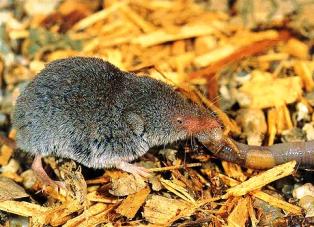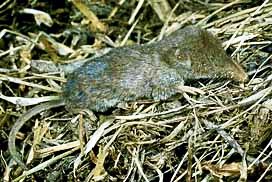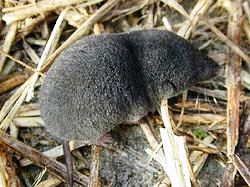Discover Florida Nature
It's time to explore the natural Florida


|
|
|
|
|
Although its external appearance is generally that of a long-nosed
mouse, a shrew is not a rodent, as mice are, and
not closely related to rodents. Shrew feet have five toes; rodent feet
have four, and shrews have sharp, spike-like teeth, not the familiar
gnawing front incisor teeth of rodents. Shrews are distributed almost
worldwide: of the major tropical and temperate land masses, only New
Guinea, Australia, and New Zealand do not have native shrews at all. All
shrews are comparatively small, most no more than mouse size. In
general, shrews are terrestrial creatures that forage for seeds,
insects, nuts, worms and a variety of other foods in leaf litter and
dense vegetation, but some specialize in climbing trees, living
underground, in the subniveal layer or even hunting in water. They have
small eyes, and generally poor vision, but shrews have excellent senses
of hearing and smell. Shrews are very active animals, with voracious
appetites and unusually high metabolic rates and must eat 80-90 % of
their own body weight in food daily. North
American Least Shrew- The Least Shrew,
Cryptotis parva, is found in dry grassy and brushy areas throughout
mainland Florida. One of the smallest mammals, the North American Least
Shrew will grow to be three inches long while its tail will grow not
more than two times the length of its hind foot, which is pretty small
to begin with. It has a white belly and grayish to reddish brown fur
that grown lighter in the summer and darker in the winter. They have
poor eyesight and hearing so they use echolocation using a multitude of
clicks and sounds to help find their way around. The least shrew uses
runways created in the leaves and grass by rodents larger than
themselves. Because their eyesight and hearing is bad, they hunt by
their smell and touch, digging through leaf litter for their prey. They
also tunnel through moist soil like moles do. The North American Least
Shrew eats insects, from the corpses of dead animals, seeds and fruit.
They bite the heads off crickets and grasshoppers in order to eat their
internal organs. When face to face with a larger creature, they will aim
for the legs in order to cripple them. They bite off the tails of
lizards, providing them with ample meat while the lizard escapes.
The North American Least shrew has been known to live inside beehives so
they can eat all the larvae and often shares its food with other shrews
before storing the leftovers. The North American Least Shrew builds its
home in burrows and shallow runways under flat stones and fallen logs.
This very social creature lines its nests with leaves and grass. Adults
breed March to November and usually produce two litters per season with
three to six young per litter. Predators include owls, hawks, weasels,
skunks, snakes, and cats. North
American Least Shrew- The Least Shrew,
Cryptotis parva, is found in dry grassy and brushy areas throughout
mainland Florida. One of the smallest mammals, the North American Least
Shrew will grow to be three inches long while its tail will grow not
more than two times the length of its hind foot, which is pretty small
to begin with. It has a white belly and grayish to reddish brown fur
that grown lighter in the summer and darker in the winter. They have
poor eyesight and hearing so they use echolocation using a multitude of
clicks and sounds to help find their way around. The least shrew uses
runways created in the leaves and grass by rodents larger than
themselves. Because their eyesight and hearing is bad, they hunt by
their smell and touch, digging through leaf litter for their prey. They
also tunnel through moist soil like moles do. The North American Least
Shrew eats insects, from the corpses of dead animals, seeds and fruit.
They bite the heads off crickets and grasshoppers in order to eat their
internal organs. When face to face with a larger creature, they will aim
for the legs in order to cripple them. They bite off the tails of
lizards, providing them with ample meat while the lizard escapes.
The North American Least shrew has been known to live inside beehives so
they can eat all the larvae and often shares its food with other shrews
before storing the leftovers. The North American Least Shrew builds its
home in burrows and shallow runways under flat stones and fallen logs.
This very social creature lines its nests with leaves and grass. Adults
breed March to November and usually produce two litters per season with
three to six young per litter. Predators include owls, hawks, weasels,
skunks, snakes, and cats.
 Southeastern
Shrew- The Southeastern Shrew, Sorex longirostris, is
found in throughout north Florida and in central Florida south to
Highlands County. It is reddish brown, 3-3.6" long, with a long (1-1.3")
tail. It weighs a mere tenth of an ounce. The Southeastern Shrew nests
under logs, stumps, and tree roots, and can be found under leaf litter
and in tunnels. The Southeastern Shrew eats spiders, moth larvae, slugs
and snails, centipedes, and vegetation, but little else is known of its
habits, although they are thought to be similar to those of the Masked
Shrew. It is sometimes called "Bachman's Shrew," after the naturalist
John Bachman, who discovered it in 1837. This shrew prefers spending a
lot of time in the underground burrows of other animals, and under the
leaf litter. As with other shrews, it hunts day and night, and preys on
small invertebrates. Small spiders are its most important food. A
Southeastern Shrew lucky enough to die of old age would expire at about
14 months, and if female, may have produced as many as three litters,
each averaging 4 young. Predators include owls,
opossums,
snakes, and cats. Southeastern
Shrew- The Southeastern Shrew, Sorex longirostris, is
found in throughout north Florida and in central Florida south to
Highlands County. It is reddish brown, 3-3.6" long, with a long (1-1.3")
tail. It weighs a mere tenth of an ounce. The Southeastern Shrew nests
under logs, stumps, and tree roots, and can be found under leaf litter
and in tunnels. The Southeastern Shrew eats spiders, moth larvae, slugs
and snails, centipedes, and vegetation, but little else is known of its
habits, although they are thought to be similar to those of the Masked
Shrew. It is sometimes called "Bachman's Shrew," after the naturalist
John Bachman, who discovered it in 1837. This shrew prefers spending a
lot of time in the underground burrows of other animals, and under the
leaf litter. As with other shrews, it hunts day and night, and preys on
small invertebrates. Small spiders are its most important food. A
Southeastern Shrew lucky enough to die of old age would expire at about
14 months, and if female, may have produced as many as three litters,
each averaging 4 young. Predators include owls,
opossums,
snakes, and cats. Southern
Short-tailed Shrew- The Southern Short-tailed Shrew,
Blarina carolinensis is found in woods, fields, and brushy areas
through out the state of Florida, except for the Keys. The Southern
Short-tailed Shrew is very similar in appearance to the Northern
Short-tailed Shrew except that it is smaller measuring about 3 - 5
inches in length and weighing about 8 grams. The Southern Short-tailed
Shrews tail is always less than half the length of the head and body.
Their color is greyish-black, sometimes with a silvery or brownish cast.
The Southern Short-tailed Shrew has a protruding snout and short
external ears which are almost concealed by its soft, dense fur.
Southern Short-tailed Shrews are well adapted for digging. They have
strong, wide front feet which are slightly larger than their hind feet.
They burrow using a combination of their forefeet, head and nose. In
soft soil, they are capable of burrowing at a rate of 30 centimeters per
minute! The Southern Short-tailed Shrew is active day and night and
throughout the year. The Southern Short-tailed Shrew builds its own
tunnels in the ground and also uses those of other animals. Runways are
used for food storage. The Southern Short-tailed Shrews diet consists of
insects, annelids, vegetable matter, centipedes,
arachnids, mollusks, vertebrates and crustaceans. The saliva is
venomous and is injected into the wounds of its prey by the teeth. The
Southern Short-tailed Shrews venom is strong enough to kill
mice, but is not lethal to humans. Two to three litters are produced
each year, with breeding occurring from early spring to late fall. After
a gestation period of about 21 days, a litter of 2-3 young is born. Southern
Short-tailed Shrew- The Southern Short-tailed Shrew,
Blarina carolinensis is found in woods, fields, and brushy areas
through out the state of Florida, except for the Keys. The Southern
Short-tailed Shrew is very similar in appearance to the Northern
Short-tailed Shrew except that it is smaller measuring about 3 - 5
inches in length and weighing about 8 grams. The Southern Short-tailed
Shrews tail is always less than half the length of the head and body.
Their color is greyish-black, sometimes with a silvery or brownish cast.
The Southern Short-tailed Shrew has a protruding snout and short
external ears which are almost concealed by its soft, dense fur.
Southern Short-tailed Shrews are well adapted for digging. They have
strong, wide front feet which are slightly larger than their hind feet.
They burrow using a combination of their forefeet, head and nose. In
soft soil, they are capable of burrowing at a rate of 30 centimeters per
minute! The Southern Short-tailed Shrew is active day and night and
throughout the year. The Southern Short-tailed Shrew builds its own
tunnels in the ground and also uses those of other animals. Runways are
used for food storage. The Southern Short-tailed Shrews diet consists of
insects, annelids, vegetable matter, centipedes,
arachnids, mollusks, vertebrates and crustaceans. The saliva is
venomous and is injected into the wounds of its prey by the teeth. The
Southern Short-tailed Shrews venom is strong enough to kill
mice, but is not lethal to humans. Two to three litters are produced
each year, with breeding occurring from early spring to late fall. After
a gestation period of about 21 days, a litter of 2-3 young is born. |
|
|
Advertise | Privacy Statement | Dog Encyclopedia | Video |Contact | Alaska Nature |
|